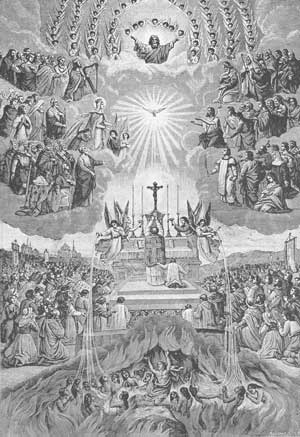Gregorian Masses are thirty Masses said at any altar for thirty consecutive days for the deliverance of a certain soul from Purgatory. The pious practice of having these Masses celebrated for the deliverance of the souls from Purgatory was not first introduced by Saint Gregory the Great, who was sovereign Pontiff from 590 to 604, but precedes his time. However, they are called Gregorian Masses because St. Gregory contributed to the spread of this pious practice. In his Dialogues the Saint tells us that he caused to be said thirty Masses on thirty consecutive days for the repose of the soul of Justus, a monk who had died in the convent of St. Andrew in Rome. At the end of the thirtieth Mass, the deceased appeared to his brother, Copoosus, who had assisted him as a physician in his last illness, and announced that he had been delivered from the flames of Purgatory.
In their “Lives of the Saints” the Bollandists tell us that on the thirtieth day Saint Gregory himself was assured of the deliverance of the soul of Justus. And an inscription in the church of SS. Andrew and Gregory, which Rome erected on the spot of the dwelling of the holy Pontiff, confirms the fact.
Saint Gregory, as we read of his life, was also instructed by God Himself in the efficacy of these thirty Masses and he recommended the practice on various occasions.
In the life of St. Vincent Ferrer, we read that he had thirty consecutive Masses celebrated for his deceased sister and saw her delivered from Purgatory.
Pope Benedict XIII lauded this pious practice of having thirty Masses said for each soul that has departed from this life.
In Italy, France, Spain, Germany and especially England, which was converted by missionaries sent by St. Gregory, it was an established custom previous to the Reformation and the French Revolution, to have thirty consecutive Masses said for each departed soul. In a number of old churches in Europe, altars dedicated to St. Gregory and the Poor Souls are to be found. Many old paintings are still preserved attesting the same fact.
Several Religious Orders have it specified in their rules and Constitutions that thirty Gregorian Masses are to be said for every deceased member. The Carmelites, Dominicans, Nuns of the Visitation, and others follow this practice. A very old edition of the Dominican Missal contains special prayers for the Gregorian Masses.
-Rules for Gregorian Masses
-How to arrange a Gregorian Mass


No comments:
Post a Comment